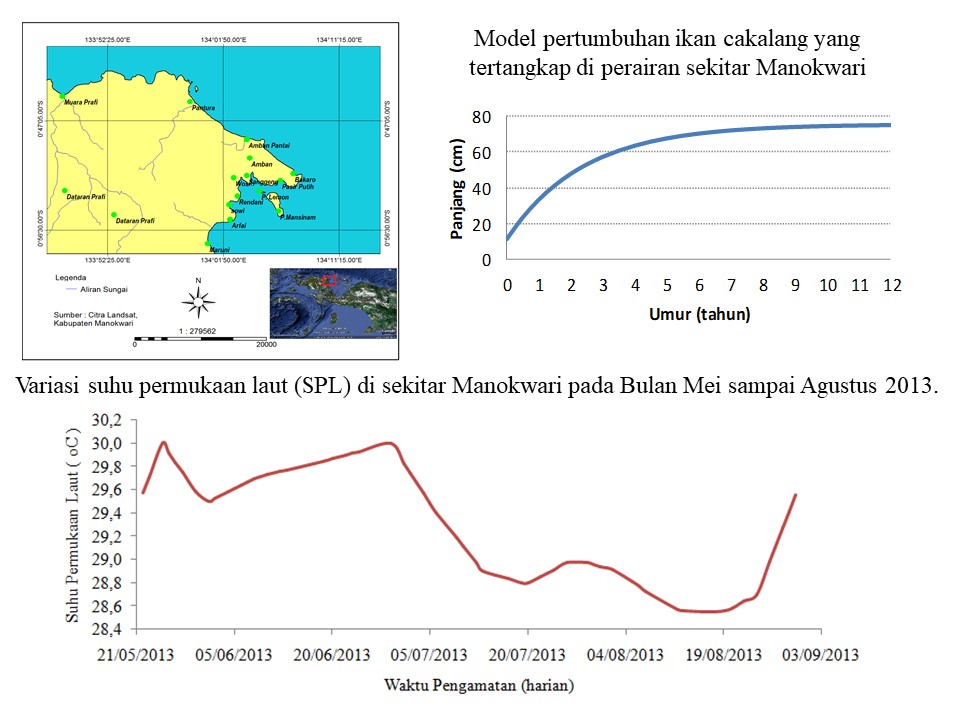Variability of Sea Surface Temperature and Its Implication to Skipjack (Katsuwonus pelamis L) Catch Taken from Water Around Manokwari, West Papua
DOI:
https://doi.org/10.46252/jsai-fpik-unipa.2020.Vol.4.No.2.108Keywords:
Skipjack tuna, fishing ground, catch, Manokwari, sea surface temperatureAbstract
The presence of skipjack fish resources in a fishing area is related to the suitability of the environmental conditions of the waters. This study aims to examine the relationship of sea surface temperature (SPL) to skipjack catches and the characteristics of skipjack catches in Manokwari waters. Data, both catch data and sea surface temperature data, are collected through field surveys by following fishing operations. Furthermore, the data were analyzed descriptively using graphs and mathematically like von Bertalanffy's growth model. The results of this study found that the very small variability of SPL could not explain the variation in the volume of fishermen's catches in Manokwari waters. However, a high SST during the May - August 2013 period is thought to affect the size of the skipjack caught, where the average size of the fish caught inhabited areas near sea level. In addition, the growth of skipjack fish in Manokwari waters is relatively fast with a growth coefficient of 0.42 per year1 and natural mortality between 0.79 per year and 0.81 per year.
Downloads
References
Gunarso, W. 1985. Tingkah laku Ikan dalam Hubungannya dengan Metode dan Taktik Penangkapan. Jur. Pemanfaatan Sumberdaya Perikanan Fak. Perikanan IPB, Bogor. 143 hal.
Hamuna B, Paulangan YP, Dimara L. 2015. Study of sea surface temperature using Aqua-MODIS satellite data in Jayapura waters, Papua. Depik 4(3):160-167.
Hampton, J. and Williams P., 2003. The Western and Central Pacific Tuna Fishery: 2001 Overview and Status of Stocks, Oceanic Fisheries Programme, Tuna Fisheries Assessment Report No.4: 42.
Hidayat T, Noegroho T, Wagiyo K. 2017. Size structure and some population parameters of skipjack tuna (Katsuwonus pelamis linnaeus, 1758) in the Pasific Ocean North of Papua. BAWAL 9(2):113-121.
Lehodey, P., Andre, J. M., Bertignac, M., Hampton, J., Stoens, A., Menkes, C., Memery L., and Grima, N., 1998. Predicting skipjack tuna forage distributions in the equatorial Pacific using a coupled dynamical bio-geochemical model. Fisheries Oceanography 7(3-4): 317-325.
Matsumoto, W., Skillman M., R. A. and Dizon, A. E., 1984. Synopsis of biological data on skipjack tuna, Katsuwonus pelamis. NOAA Techical Report NMFS Circular 451: 1-92.
Muklis, J.G.L dan Domu S., 2009. Potensial Fishing Ground Mapping of Skipjack (Katsuwonus pelamis) and Frigate Tuna (Euthynnus affinis) In North Nanggroe Aceh Darussalam Waters. E Jurnal Ilmu dan Teknologoi Kelautan Tropis 1(1): 24-32
Pauly, D. 1980. On the Interrelationships between Natural Mortality, Growth Parameters, and Mean Environmental Temperature in 175 Fish Stock. J. Cons. Int. Explor. Mer. 39(2): 175-192.
Sala, R., 2008. Estimation of Optimum Fishing Mortality and Minimum Legal Size of Skipjack Tuna in the Northeastern Waters of Indonesia. Jurnal Perikanan dan Kelautan 4(2): 119 – 126.
Sala, R., 2009. Composition of Skipjack Tuna (Katsuwonus pelamis L) Taken by Commercial Fishery from the Northeastern Waters of Indonesia. Indonesian Journal of Marine Sciences 14(4): 207 – 214.
Sala, R., 2017. Relative abundance of skipjack tuna (Katsuwonus pelamis L.) in waters around Sorong and Fak-Fak, West Papua, Indonesia. AACL Bioflux 10(3): 551-564.
Sharp GD. 1978. Behavioural and physiological properties of tunas and their effects on vulnerability to fishing gear. In: D. SG, Dizon AE (Eds). In: The physiological ecology of tunas. New York: Academic Press. p 397-449.
Simbolon D and Limbong, M., 2012. Exploration of skipjack fishing ground through sea surface temperature and catches composition analyzes in palabuhanratu bay waters. Journal of Coastal Development 15(2): 225- 233.
Sparre P, Venema SC. 1998. Introduction to tropical fish stock assessment. Part 1. Manual.: FAO, Rome.
Tanabe T. 2001. Feeding habits of skipjack tuna Katsuwonus pelamis and other tuna Thunnus spp. juveniles in the tropical western Pacific. Fisheries Science Tokyo 67(4):563-570.
Wild A, Hampton J. 1994. A Review of the Biology and Fisheries for Skipjack Tuna, Katsuwonus pelamis in the Pacific Ocean. In: Shomura RS, Majkowski J, Langi S, editors. Interactions of Pacific Tuna Fisheries: Paper in Biology and FisheryProceeding of First FAO Expert Consultation on Interaction of Pacific Tuna Fisheries, 3-11 December 1991, Noumea, New Caledonia. FAO Fisheries Technical Paper. Rome. p 1-51.



















